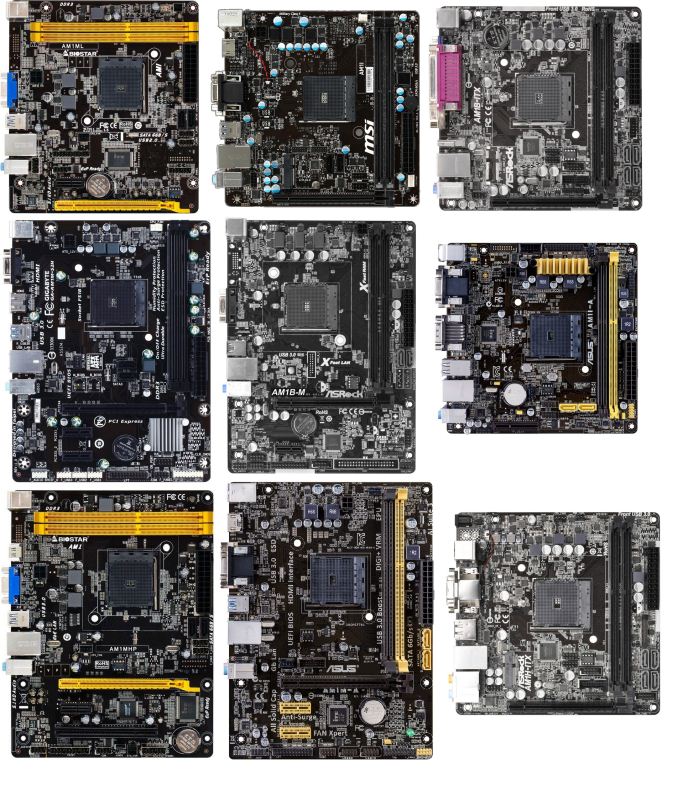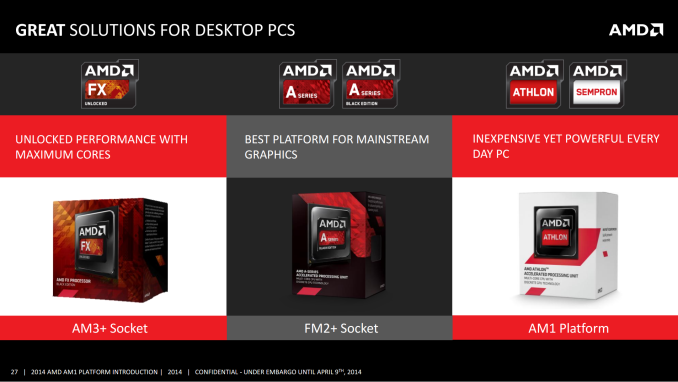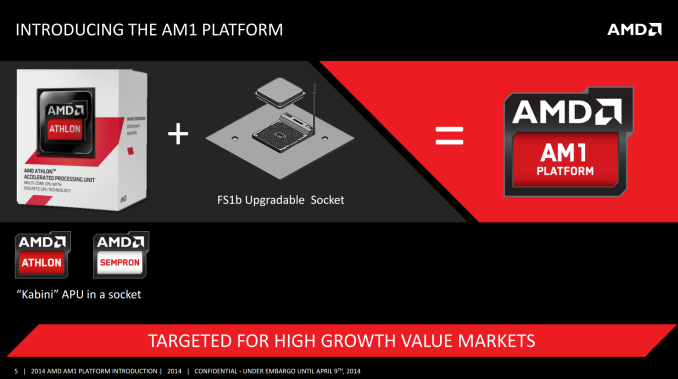The AM1 Kabini Motherboard Preview: Analyzing the Hardware
by Ian Cutress on April 19, 2014 2:00 PM EST
One of AMD’s primary feature points for the AM1 Kabini platform was the introduction of low-cost motherboards. The promotional material provided gave a suggested AM1 combined price of $60. Now after release the cheapest APUs are $31 for a dual core and $35 for a quad core. This should mean motherboards from $29 and up. Today we take a brief preview of nine motherboards currently on sale, which start at $33.
The AM1 Ecosystem
Almost every end-user I converse with prefers naming consistency in technology products. There has to be a clear progression in naming structure showing the development of a platform over time and generations. There have been plenty of examples – AMD’s enthusiast chipset (580/690/790/890/990FX), both AMD and NVIDIA’s GPU lines, Intel’s chipsets (P35, X48, P55, P67, Z77, Z87). The issue arises when the naming scheme is non-contiguous. The naming of AMD’s three main processor and chipset lines are as follows:
The top end features the AM3+ socket, which came from AM3, AM2+ and AM2. The mid-range is the FM2+ socket, deriving from FM2 and FM1. The low-price segment is now being called the ‘AM1 platform’. It makes it sound like it should be a very old version of AM3, because at least colloquially it will just be called AM1. In reality, that word ‘platform’ is the kicker here, because the socket is actually called FS1b:
What makes it called the AM1 platform is the use of a Kabini APU in an FS1b upgradable socket. That does not help that all the motherboards on sale will be given the AM1 designation. This means that if the next iteration of the Athlon processors using ‘Puma’ cores (codename “Beema”) comes along and they call it the ‘AM2 platform’ (insert more confusion with the AM2 socket), it might still be the FS1b socket in the middle of the motherboard.
Naming conventions aside, because Kabini processors are system-on-chips rather than platforms with a discrete south bridge, all the IO is determined on die. AMD is at least keeping the core of the IO the same across all the Kabini APUs:
The key points to note here are:
- Single Channel 64-bit DDR3/DDR3L
- Two USB 3.0
- Eight USB 2.0
- PS/2
- Trusted Platform Module Support
- Up to four eDP/DP/HDMI video outputs
- VGA output
- Four PCIe 2.0 lanes for a discrete GPU/PCIe device
- Two SATA 3 Gbps ports
- One PCIe 2.0 x1 lane allocated to an Ethernet controller
- Three PCIe 2.0 x1 lanes for other controllers (SATA, USB, LAN, WiFi, PCIe 2.0 x1 slots, PCIe to PCI bridges)
As we go through the following motherboards, we will see that some manufacturers use USB 3.0 or SATA 6 Gbps controllers, powered by the PCIe 2.0 x1 lanes, in order to bump up the functionality. There is scope for development in the networking and audio solutions as well.













64 Comments
View All Comments
Chrispy_ - Saturday, April 19, 2014 - link
The whole concept of an expensive AM1 motherboard is ridiculous, because as metioned in the article, once the CPU+platform cost reaches about $80 you could buy an FM2 solution which would be significantly more powerful and have many more features.Asus, in this case, completely misses the point.
silverblue - Saturday, April 19, 2014 - link
Yet it would be a dual core, with a much higher TDP. None of these Kabini boards are full ATX, either, so you're not forced into a large form factor.Admittedly, I would go FM2/FM2+ as I would want the performance, but I could make a much smaller and quieter PC with Kabini for obvious reasons.
johnny_boy - Monday, April 21, 2014 - link
Exactly (about the TDP). There's still reason to go AM1 over FM2(+) purely for thermal/wattage reasons. I was eyeing a super small ITX case with 60W pico PSU for HTPC use that could also serve for NAS purposes and be always on. I wouldn't run a 65-100W FM2 chip 24/7 or for HTPC use unless I wanted to do some light gaming.Ortanon - Monday, April 21, 2014 - link
This actually insinuates that a low-energy/low-heat desktop solution has a price premium the same way a high-performance desktop solution does. That kind of makes sense on the surface, but when you think about it things don't add up. A lower-TDP solution is necessarily less performant, but higher-TDP solutions aren't necessarily loud, and the differences in power draw are often negligible in terms of energy costs.All in all, a weaker system should be cheaper. Plain and simple. When I saw that it'd be at least $75 for an AM1 CPU/mobo, I just shook my head and moved along. Also they REALLY should've figured out a way to squeeze dual-channel into the spec.
My fantasy is for an AM1 board that has nothing but RAM slots and two full mini-PCIE slots. That's it. You slide a board full of cards into a tiny-ass case and boom. No stupid cables, no nothing. Hell, there's your under-$40 mobo right there. How difficult is that? I've been waiting for that for SO MANY years, and yet...
RoboJ1M - Tuesday, April 22, 2014 - link
You forgot no daft ATX+12 connector rubbish.You just want a DC jack on the back plate and some switched converters on board.
And an HDMI and a USB port on the back.
But yeah, that's what I'm looking for as well.
Case + Mobo + CPU + Ram + Laptop PSU = Internet PC.
Ortanon - Tuesday, April 22, 2014 - link
There are already SFF PSUs so that doesn't bother me as much. It just confuses me that after so many years of having mini-PCIe/mSATA, so few mini-ITX (!) motherboards have it, and far fewer than that have two (for your WiFi + SSD scenarios).Stand-alone cases could get a LOT smaller if that one change was made, not to mention the elimination of at least two cables from the build.
Really, I'd be looking to use full-speed mSATA storage on ANY size setup. The cards don't cost extra anymore.
solos - Friday, November 20, 2015 - link
Buy a notebook with broken screen (for next to nothing) , keep the bottom case and have your wish fullfilled ;)Flunk - Sunday, April 20, 2014 - link
If you don't produce things to hit different points of the market, how will you know they won't sell? It's worked for ASUS before.Samus - Monday, April 21, 2014 - link
Asus missed the point? ASRock is the one charging $60!ntgeralt - Saturday, April 19, 2014 - link
test